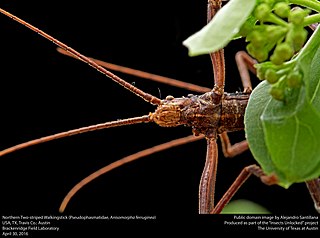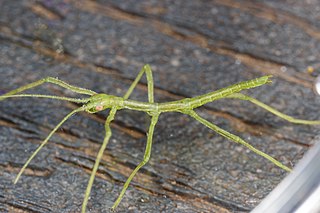
Parabacillus hesperus, the western short-horn walkingstick, is a species of walkingstick in the family Heteronemiidae. It is found in North America. This species is found in dry, arid in the summer and fall. Their diet consists of various scrub and grassland plants. Through an adaptation called "crypsis," it blends in so perfectly with its natural habitat that it often goes completely undetected by would-be predators.

Anisomorpha ferruginea is a species in the family Pseudophasmatidae, in the order Phasmida ("walkingsticks"). Common names include "northern two-striped walkingstick", "dark walkingstick", and "prairie alligator". Anisomorpha ferruginea is found in North America.

Diapheromera is a genus of stick insects in the family Diapheromeridae. There are about 14 described species in Diapheromera.
Diapheromera persimilis, the similar walkingstick, is a species of walkingstick in the family Diapheromeridae. It is found in North America.

Megaphasma denticrus, the giant walkingstick, is a species of walkingstick in the family Diapheromeridae. It is found in North America.

Megaphasma is a genus of walkingsticks in the family Diapheromeridae. There are at least two described species in Megaphasma.

Diapheromera velii, the prairie walkingstick, is a species of walkingstick in the family Diapheromeridae. It is found in North America.
Manomera is a genus of walkingsticks in the family Diapheromeridae. There are at least three described species in Manomera.

Pseudosermyle is a genus of walkingsticks in the family Diapheromeridae. There are more than 20 described species in Pseudosermyle.
Timema nevadense, the Nevada timema, is a species of walkingstick in the family Timematidae. It is found in North America.
Manomera blatchleyi, the blatchley walkingstick, is a species of walkingstick in the family Diapheromeridae. It is found in North America.
Haplopus is a genus of walkingsticks in the family Phasmatidae. There are about seven described species in Haplopus.

Timema genevievae, or Genevieve's timema, is a species of walkingstick in the family Timematidae. It is found in North America.
Parabacillus coloradus, the Colorado short-horn walkingstick, is a species of walkingstick in the family Heteronemiidae. It is found in North America.
Timema boharti, or Bohart's timema, is a species of walkingstick in the family Timematidae. It is found in North America.
Diapheromera carolina, the Carolina walkingstick, is a species of walkingstick in the family Diapheromeridae. It is found in North America.
Timema podura, the Sierra Nevada timema, is a species of walkingstick in the family Timematidae. It is found in North America.

Timema chumash, the chumash timema, is a species of walkingstick in the family Timematidae. It is found in North America.
Pseudosermyle catalinae, the Catalina walkingstick, is a species of walkingstick in the family Diapheromeridae. It is found in North America.
The 2019 Cherokee Nation of Oklahoma principal chief election was held on Saturday, June 1, 2019. Former Cherokee Nation Secretary of State Chuck Hoskin, Jr. defeated Tribal Councilman Dick Lay in the election.








